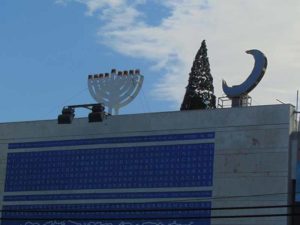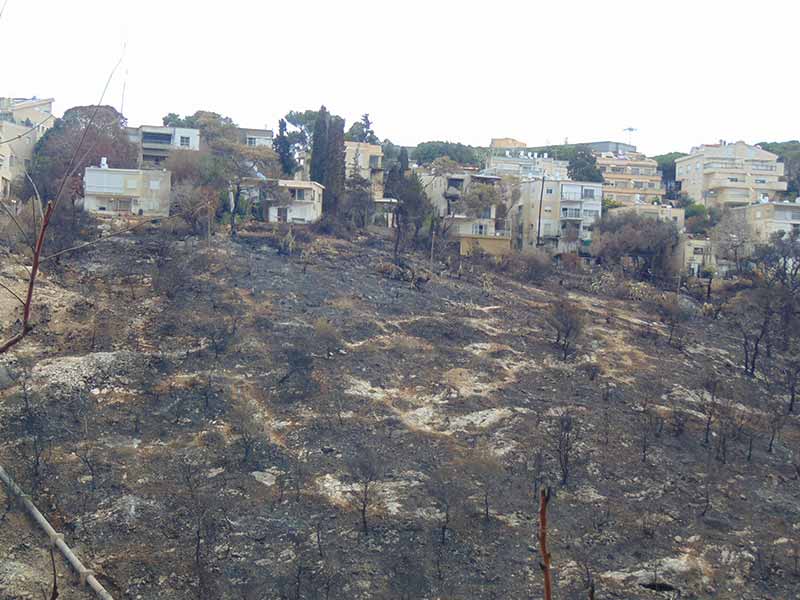The fires here are now out, but the smell of smoke lingers in the air. A wave of fires raged throughout Israel for eight days in late November 2016 after two months of drought. Haifa was hardest hit, with an estimated 1,700 citizens left homeless. Now, the task of rebuilding must begin, and the theme here is coexistence.
Haifa Mayor Yona Yahav believes it’s nothing special that Arab and Jewish citizens are pitching in to help each other out. “It’s just normal,” he says.
Two weeks after the fires, on Dec. 2, Haifa kicked off its annual “Festival of Festivals” celebration (also known as “Holiday of Holidays”) on schedule, promoting light and joy among all three of its primary faiths. “Never postpone a festival,” Yahav says.
READ: WITH WILDFIRES TAMED, ISRAEL SEEKS ANSWERS
Assaf Ron, executive director of Beit HaGefen, the Jewish Arab cultural centre that runs the festival, says the centre’s projects, including a theatre, library, and art activities, share the “two dominant narratives” of life in Israel. “For me, 1948 is independence; for [others], it’s nakba” (“catastrophe” in Arabic).
“It’s hard to connect two societies which are fed by dominant ‘victim’ stories,” says Ron. But at the festival, “we are all looking at lights.”
Haifa is Israel’s third-largest city and 82 per cent of Haifa’s residents are Jewish, 14 per cent are Christians, mostly Arab, and four per cent are Muslim. Beit HaGefen works hand in hand with the city to ensure that, as Ron puts it, that “your narrative and my narrative can both live together.”
After the blazes were quenched, thanks in part to the first heavy rains of winter, Haifa was left to begin rebuilding.
“It’s devastating to see this,” says Haifa city engineer Ariel Waterman. Standing overlooking a scorched valley which should be green and rustling to life after the first rain since May, he points out hellish, blackened areas where fires leapt from one area to another.
During the fires, media quickly blamed “arson terrorism.” Social media lit up with images of Arabs celebrating the destruction of Jewish towns and homes. The hashtag #Israelisburning trended on Twitter.
Israel’s Prime Minister Benjamin Netanyahu implied that the simultaneous fires could not have been coincidental. And Education Minister Naftali Bennett tweeted that the fires could only have been set by “someone who this land does not belong to.”
READ: THOUSANDS EVACUATED AS FIRES RAGE
Yet in Haifa, coexistence went on as usual. “There’s not one Arab municipality of any size that didn’t offer help,” Yahav says. Eight Palestinian Authority fire trucks, carrying approximately 40 firefighters came to Israel to assist.
Arab residents offered assistance to those hardest hit, says Ron. “If an Arab restaurant owner went to a centre and brought food, we don’t write ‘an Arab brought food.’ It’s just not unusual. If my father is in the hospital, 35 per cent of his doctors are Arabs.
“This is a city with an atmosphere of shared society and dialogue,” says Ron. With Haifa’s Arab population of up to 50,000, he is proud that no Jewish citizens publicly condemned their neighbours.
In the aftermath, Yahav believes the city must support its citizens. “You are elected to care about the people.”
Large banners wave over scorched neighbourhoods: “Repairing the fire damage: Stage One.”
“During the Lebanon war,” Waterman says, “if a building got hit, we started rebuilding within five hours. Here, we’re not waiting even one week.”
Unfortunately, it’s too late for many homes. If a steel-reinforced structure burns for too long, the building must be torn down, even if only a few units are affected. Yet city engineers still rushed to cover destroyed homes with huge sheets of plastic. This helped save contents like precious heirlooms from being destroyed by rain. “It makes a difference to the homeowner,” said Waterman. “We’re taking care of the people, not only the house.”

Yahav estimates that the cost to rebuild public spaces will be a half-billion shekels (more than $172 million), with an equal cost to compensate homeowners. He claims his municipality has received no contact from JNF, and credits the International Fellowship of Christians and Jews (Keren Hayedidut) as the only international organization which has offered aid.
Today, in the hardest-hit Horev and Ahuza neighbourhoods, dumpsters overflow with the contents of homes and building materials too far gone to save. Workers clamber in and out of homes, and there is an almost-cheerful buzz of activity as the city pulls itself up by its bootstraps.
“The municipality is doing amazing work,” says Meir Barzilay, a bank manager and Ahuza resident. “They’re taking care of us.”
Questions of terrorism may never be resolved. Most suspects have been released unconditionally. However, of one fire, which began next to a fire station, Waterman says, “They didn’t catch anyone… but it cannot be a coincidence.”
Regardless, he cites numerous lessons learned. The city may ban wooden pergolas, which attract flames. Residents were also often not advised to close windows, which may have allowed fire to leap inside. And cooking gas, which is usually delivered in individual tanks, will likely be stored underground in new developments.
The city will continue removing trees to create fire breaks between wooded areas and housing. In some areas, this prevented damage during the recent fires. “This is a unique city, one where nature strongly penetrates the urban fabric,” says Waterman.
Finally, the city must plant different trees. Most Israeli forests are pine, a non-native species which ignites quickly. Pine cones can also explode, spreading the blaze.“We are rethinking many things,” he says.
But when it comes to coexistence, there’s no rethinking necessary. Yahav says he didn’t need to reach out specifically to Arab residents to reassure them during or after the fire. “This is the only city in the world with full peace between Jews and Arabs for the last 115 years. Here, we don’t differentiate. We have to prove to individual citizens that we care about them.”
